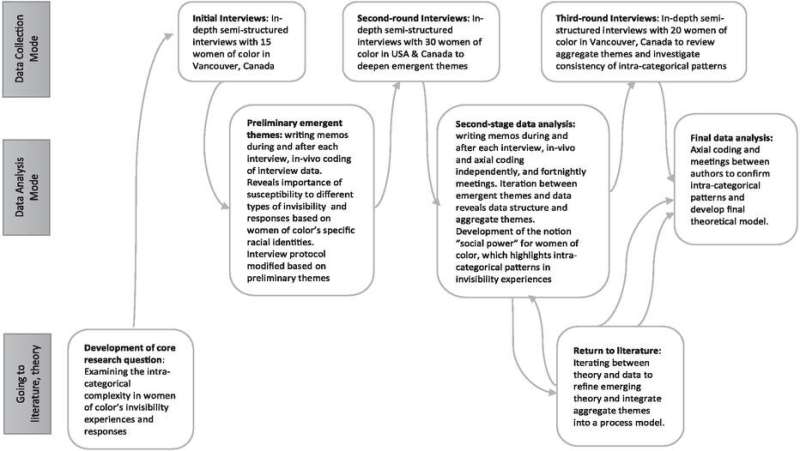This article has been reviewed according to Science X's editorial process and policies. Editors have highlighted the following attributes while ensuring the content's credibility:
fact-checked
peer-reviewed publication
trusted source
proofread
Do you see me? New study examines how women of color experience invisibility in the workplace

Invisibility is a salient and recurring experience of mistreatment for women of color working in traditionally white and male professions, two researchers found in their recent study. Barnini Bhattacharyya of the Ivey Business School at Western University and Jennifer Berdahl of University of British Columbia looked at a diverse sample of 65 women of color in Canada and the U.S. for the study.
Their paper, Do you see me? An Inductive Examination of Differences Between Women of Color's Experiences of and Responses to Invisibility at Work, was recently published in the Journal of Applied Psychology.
The study examines how differences in race, immigration status, age, and organizational status—which determined the women's proximity to social power—informed the types of invisibility they experienced, as well as their responses to invisibility. Although there is much research examining workplace mistreatment experiences of women in general, very little research explores how women of color experience and respond to workplace mistreatment.
"The study offers a more theoretically complete understanding of the experiences of invisibility for a variety of women of color at work," said Bhattacharyya. "By interviewing a diverse sample of women of color, we identified distinct forms of invisibility that made them feel unseen for their true selves"
Powerful and revealing interviews show the experience of invisibility was common, painful, and dehumanizing for women of color, and identified four distinct forms of invisibility:
- Erasure, invisibility in its most literal sense, means being unheard or unseen. Ninety-five percent of interviewees reported experiencing erasure at work. East/Southeast Asian women experienced erasure the most acutely frequently;
- Homogenization is being treated like a homogenous and interchangeable member of an unrelatable out group. Eighty-six percent of interviewees reported homogenization, often describing being treated as virtually indistinguishable from other women of color. Even though Black women made up less than one-fifth of the sample, they represented one-third of those who experienced homogenization most acutely and frequently;
- Exoticization is a unique race and gender-based sexualization that made women of color feel reduced to foreign objects of fascination and fetishization. Seventy-eight percent of interviewees experienced exoticization. Although most participants across racial groups reported exoticization, a disproportionate number of those women were younger and of lower organizational status. Further, every Latina woman and all but one Black woman noted being exoticized; and,
- Whitening is when one's similarities to white people are highlighted and complimented and non-white racial/ethnic identities and cultural backgrounds discounted and ignored. Fifty-one percent of interviewees reported whitening, which was confusing because it was framed as inclusion and praise, but undermined the women's racial and cultural identities, making them feel invisible. Most of the interviewees who reported whitening had grown up in Canada or the U.S., were older, and/or had high organizational status.
Importantly, the study identified three distinct responses to experiencing invisibility in the workplace. How women of color attributed causes of their invisibility, combined with their social power, shaped whether they engaged in withdrawal, approach, or pragmatic responses.
In general, women of color with less social power at work experienced invisibility most strongly. They were more likely to blame themselves for their invisibility, and were more likely to engage in withdrawal (e.g., further staying quiet, making themselves small), which intensified their invisibility and marginalization. Women with more social power experienced less invisibility.
They were more likely to blame the perpetrator for their invisibility, and were more likely to engage in approach tactics (e.g. speaking up strongly against an invisibility experience, challenging the perpetrator), which risked backlash. Women who attributed their invisibility to structural causes (e.g. systemic racism, systemic sexism) were more likely to engage in pragmatic tactics. Although least common among the interviews, such tactics often empowered women to engage in radical honesty with those who had made them feel invisible.
"Our findings offer novel insights for organizational practices around diversity and inclusion by highlighting the complexity that exists within women of color's experiences at work," said Bhattacharyya. "Some are more invisible than others, and women of color experience, and respond to, invisibility in different ways depending on their identities and positions. This also gives women of color legitimacy and language about subtle workplace mistreatment experiences."
While the paper's findings provide insight into the unique marginalization of women of color in the workplace, they also highlight the need to design more sophisticated practices around Equity, Diversity, and Inclusion (EDI) at work. In particular, there is a need to pay attention to different ways in which marginalized groups experience mistreatment at work, and design EDI policies and tools that address them accordingly.
Typically, there is a blanket EDI approach and solution (e.g. gender bystander intervention training) that only serves a few. Organizations also need to create climates and conditions for dialogue, where radically honest conversations can occur in psychologically and socially safe environments that recognize structural barriers to women of color's visibility and inclusion in organizations.
More information: Barnini Bhattacharyya et al, Do you see me? An inductive examination of differences between women of color's experiences of and responses to invisibility at work., Journal of Applied Psychology (2023). DOI: 10.1037/apl0001072
Journal information: Journal of Applied Psychology
Provided by University of Western Ontario



















